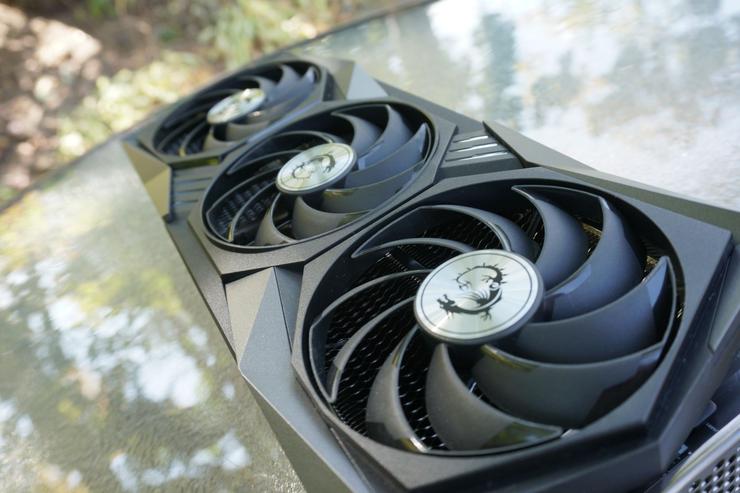 Credit: Brad Chacos/IDG
Credit: Brad Chacos/IDG
No graphics card spits out gaming frame rates as fast as Nvidia’s GeForce RTX 3090, and its massive 24GB of GDDR6X memory makes it an insanely good value for creators—yes, even at its staggering $1,500 baseline price. We already covered all that in our exhaustive Nvidia GeForce RTX 3090 Founders Edition review. But pushing this much performance takes a lot of power, and a lot of power needs heavy-duty cooling. Can beefy custom coolers tame the RTX 3090 more effectively than Nvidia’s own card? That’s what we’re examining with this review of the $1,589 MSI RTX 3090 Gaming X Trio.
We’ve already rendered verdict on this battle in another form. Stepping down quite a bit in price, the $760 GeForce RTX 3080 version of the Gaming X Trio and Nvidia’s rival 3080 Founders Edition both earned top marks, and our Editors’ Choice award. We gave MSI’s model the nod for acoustics and thermals, though, as its beefy triple-slot cooler proved more effective than Nvidia’s dual-slot card.
Nvidia beefed up its Founders Edition for the RTX 3090 though, expanding it to fill three slots with exceptional results. MSI stuck with the same basic design for both the RTX 3080 and the RTX 3090. Does the Gaming X Trio remain potent enough to justify its $89 price premium over the Founders Edition at this level of performance? Let’s dig in.
Editor’s note: We’re mostly going to focus on cooling and gaming performance in this review to compare designs. For a deeper analysis of the RTX 3090’s various use cases, including content creation and 8K gaming, be sure to check out our exhaustive GeForce RTX 3090 Founders Edition review, or our shorter 5 things to know about the RTX 3090 for a briefer overview. If you’re only interested in gaming results, the GeForce RTX 3080 provides much better value.
MSI GeForce RTX 3090 Gaming X Trio specs, features, and design
The basic tech specs for the MSI Gaming X Trio largely mirrors those of Nvidia’s Founders Edition, because they’re based on the same RTX 3090 chip using the new “Ampere” GPU architecture. Check out our GeForce RTX 3080 Founders Edition review for a deeper look at what’s new in Ampere.
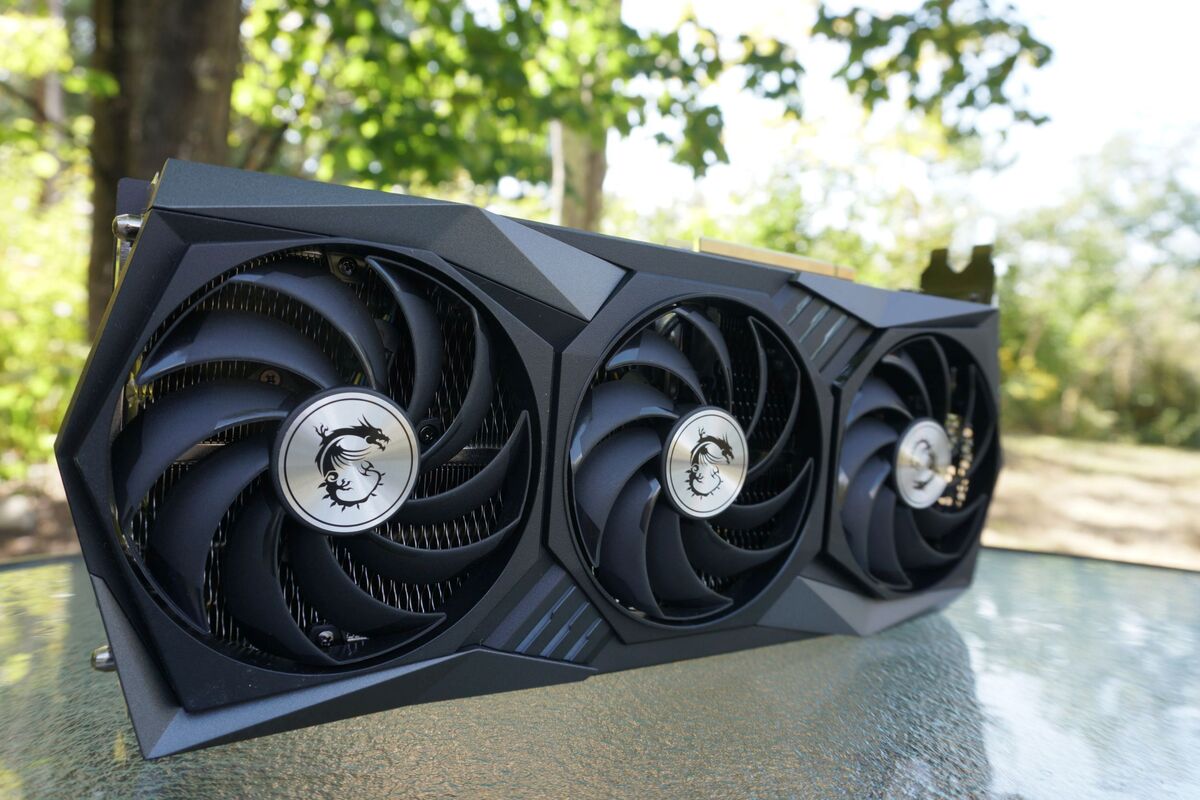 Brad Chacos/IDG
Brad Chacos/IDGHere’s a high-level look at the MSI GeForce RTX 3090 Gaming X Trio’s specs:
- CUDA cores: 10,496
- Boost clock: 1,785MHz
- Memory: 24GB GDDR6X
- Memory bus: 384-bit
- Memory bandwidth: 936 GB/s
- RT cores: 82 (2nd-gen)
- Tensor cores: 328 (3rd-gen)
- NVLink SLI: Yes
- PCIe: Gen 4
- HDMI: 2.1
- HDCP: 2.3
- Display connectors: 1x HDMI 2.1, 3x DisplayPort 1.4
- Power connectors: 3x 8-pin (with supplied 12-pin adapter)
There are only two key differences on the spec sheet (well, aside from the price) compared to the Founders Edition. First up: The GPU clock speed. While Nvidia’s card comes clocked at the 1,700MHz reference spec for the RTX 3090, MSI bumps it up to 1,785MHz on the Gaming X Trio.
That doesn’t tell the whole story though. The way Nvidia’s boost clock algorithms work, they’ll increase speed as much as thermal headroom and fan profiles allow. In practice, during a 5-lap run in F1 2020, we saw the Nvidia Founders Edition deliver consistent clock speeds of 1,785MHz to 1,815MHz. The Gaming X Trio, on the other hand, fluctuated clock speeds with much more variance. We saw speeds between 1,740MHz and 1,935MHz in the same GPU-focused benchmark, most often falling in the mid-1,800s. The wild variance likely explains why we see varied results versus the Founders Edition in our gaming benchmarks later.
MSI also uses a different power delivery system. While Nvidia’s radical cooler uses a just-as-radical proprietary 12-pin connection that requires the use of an (ugly) adapter with a pair of 8-pin power connectors, the Gaming X Trio sticks to a trio of standard 8-pin power connectors. That theoretically gives the card more overclocking headroom, and lets it reduce power demands on your motherboard’s PCIe connection. Nvidia recommends using a 750W power supply with its GeForce RTX 3090, but at the time of publication, MSI didn’t provide PSU guidance for its card.
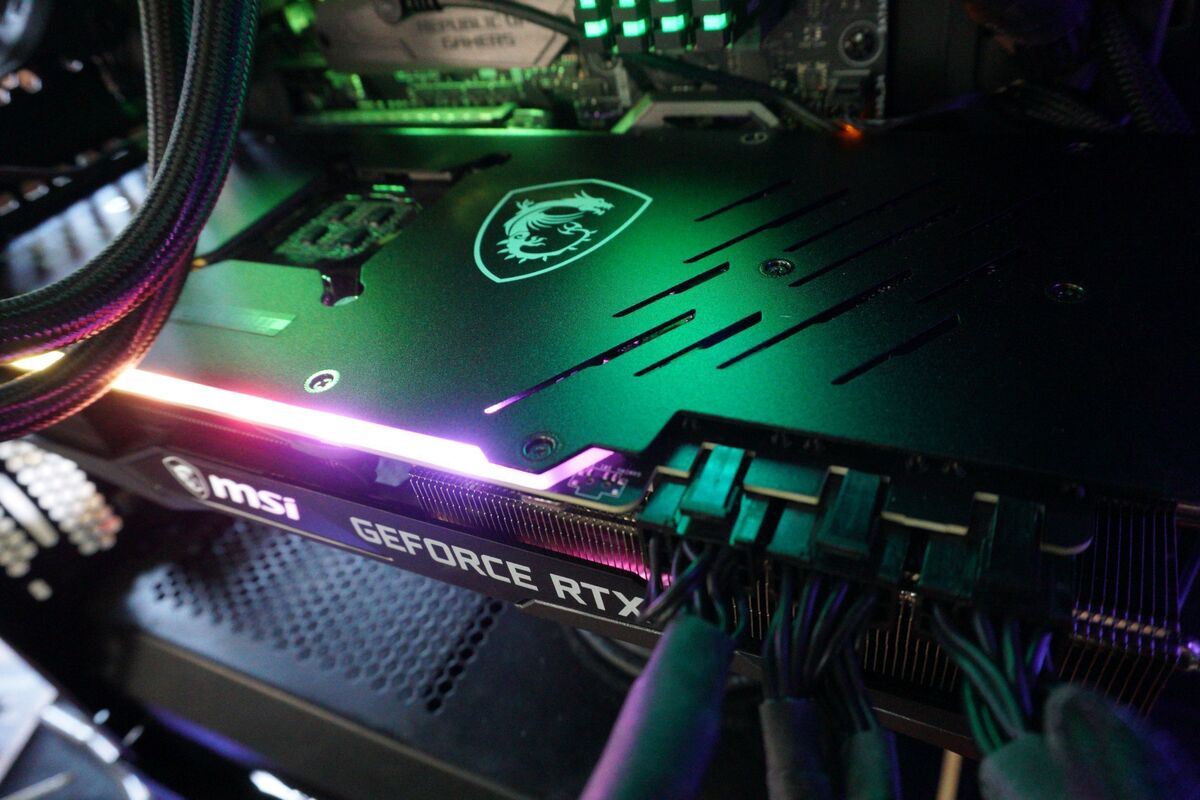 Brad Chacos/IDG
Brad Chacos/IDG
One, two, three 8-pin connectors
Finally, it’s worth noting the 24GB of GDDR6X memory. That massive VRAM buffer lets creators do things that simply aren’t possible with lower-cost GeForce cards, including the almost-as-powerful GeForce RTX 3080. If you need it, you know it, and its inclusion actually makes the RTX 3090 a killer value for prosumers, as the RTX Titan it’s replacing cost $1,000 more for a slower GPU and the same 24GB of VRAM. NVLink is another key spec for pros, as it’s not offered on any other GeForce RTX 30-series option.
The real difference lies in the cooler, though. Nvidia expanded the RTX 3080’s dual-slot Founders Edition cooler to fill three slots with the RTX 3090, but MSI slapped the same massive triple-slot “Tri Frozr 2” cooler on both versions of the Gaming X Trio. It kicks ass though, running cool and quiet.
MSI threw a ton of custom engineering into the Gaming X Trio’s design, and you can read all about it in our RTX 3080 Gaming X Trio review. The gargantuan cooler drops a trio (hence the name) of MSI’s Torx 4.0 axial fans atop a fat heatsink bristling with metal fins and five full-length heatpipes. This is a big card, so to help it stand robust, MSI reinforced its design with additional metal straps, a graphene-infused backplate that’s both stronger and dissipates more heat than plastic alone, and an optional support bracket bundled in the box. MSI also packed extra fuses onto the board for power protection and enhanced the PCB with copper to help with heat dissipation and reliability.
 Brad Chacos/IDG
Brad Chacos/IDG
Graphene is stronger than plastic, but it looks like plastic, and metal would be nice in such a high-priced card.
This is a significant custom cooler. Again, go read our review of the RTX 3080 Gaming X Trio for a much deeper dive into the tech under the shroud. We didn’t get into it much with the RTX 3080 version, but since we’re talking about a nearly $1,600 graphics card now, I wish MSI opted for a metal backplate and shroud rather than the plastic and graphene this card uses, just to make it feel a bit more premium. That would have added even more weight, though.
Speaking of the shroud, you know this card comes with RGB LEDs. The Gaming X Trio includes a thin RGB light strip on the edge of the card, accent lights around the fans in the shroud, and the MSI logo on the side of the card also illuminates. You can tweak them using MSI’s “Mystic Light” RGB controls via the company’s Dragon Center control app, and tweak your card’s performance using MSI’s fantastic Afterburner overclocking and GPU monitoring app, which remains a go-to for enthusiasts.
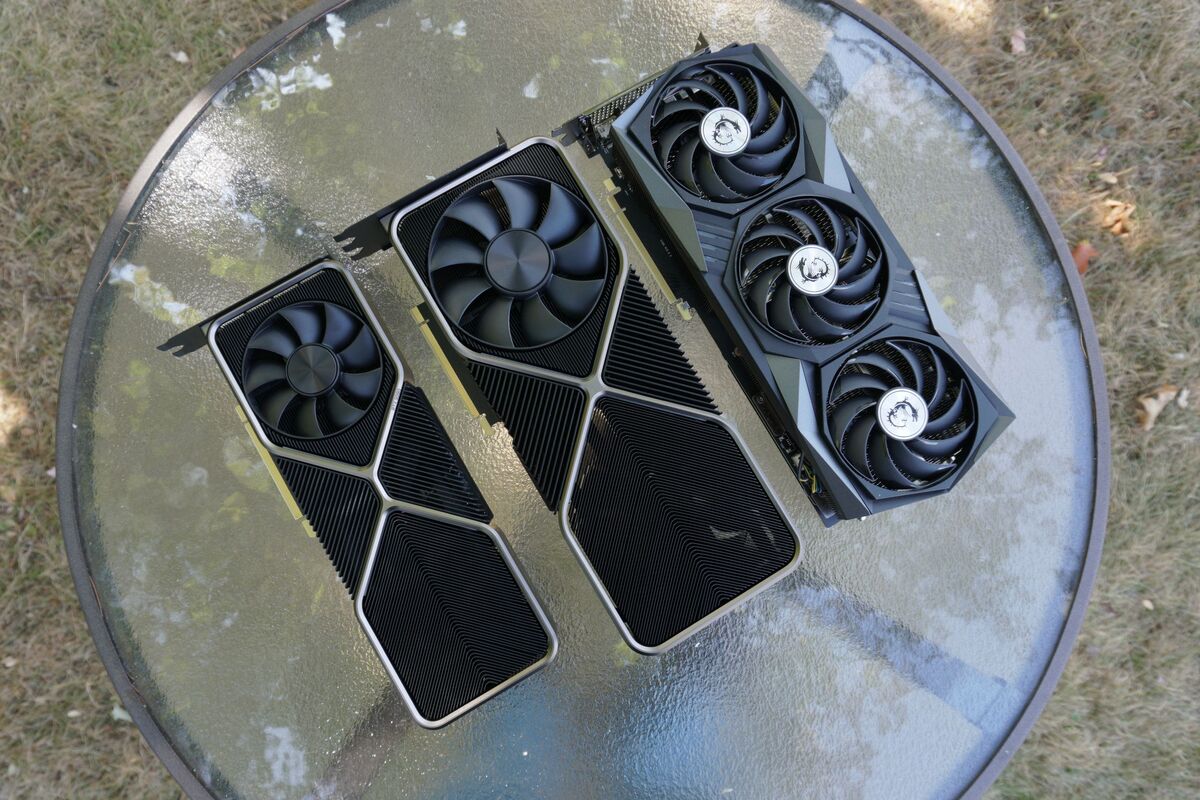 Brad Chacos/IDG
Brad Chacos/IDG
Left to right: Nvidia GeForce RTX 3080 Founders Edition, then Nvidia RTX 3090 FE, then MSI RTX 3090 Gaming X Trio.
Between the shining lights, fat heatsink, and trio of power pins, the MSI Gaming X Trio gives off a very aggressive “gamer” vibe. That’s typical for consumer graphics cards, but if you’re a creator who wants the RTX 3090 for its 24GB of VRAM and GPU acceleration chops, it might not be a style you appreciate. The sleek, all-metal Nvidia Founder Edition looks much more sophisticated in your case if that’s the sort of thing that matters to you.
Neither design is conducive to fitting more than two cards in a standard PC case thanks to their 3-slot size and fans that exhaust heat into the case. If you’re a pro who wants to shove several GeForce RTX 3090s into a single workstation, we’ve seen a Gigabyte RTX 3090 that sticks to a 2-slot design with a blower-style cooler to fully exhaust GPU heat from your system, but it’s unknown whether that style of cooling offers the full performance of the power-hungry 3090 chip.
None of this matters for gamers, who should stick to one graphics card because SLI is dead.
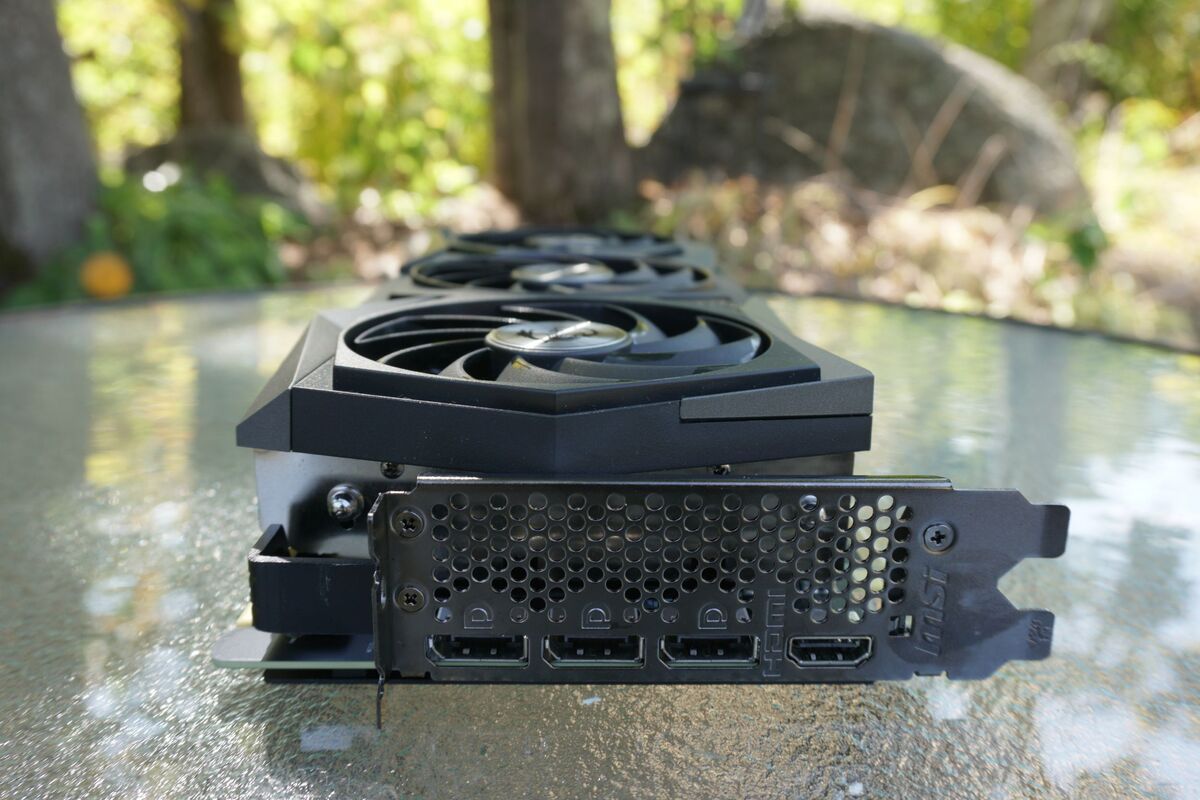 Brad Chacos/IDG
Brad Chacos/IDG
Port report.
MSI stuck to the stock output configuration for the RTX 3090, with a single HDMI 2.1 port capable of powering an 8K display paired with three DisplayPort 1.4a connections. If you’re a gaming enthusiast who wants a pair of HDMI 2.1 ports for powering both an 8K display and a VR headset, the rival Asus TUF RTX 3090 offers that capability. To bolster that newfound 8K support, Nvidia infused the RTX 30-series with AV1 decoding to better handle 8K streams, and the ability to natively capture 8K/30 video with GeForce Experience’s Shadowplay feature.
Enough talk. To the test bench!
Next page: Our test system, benchmarks begin

















